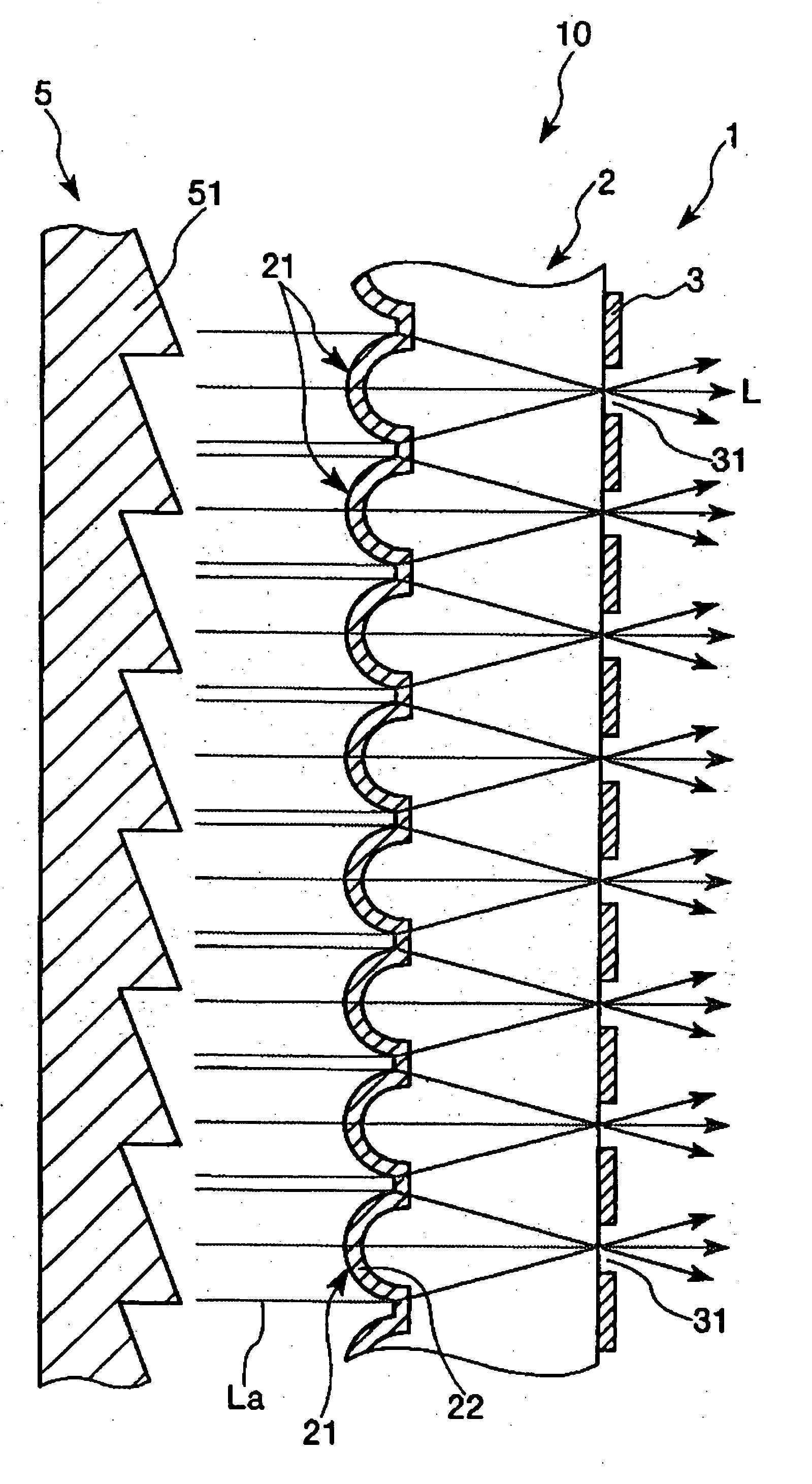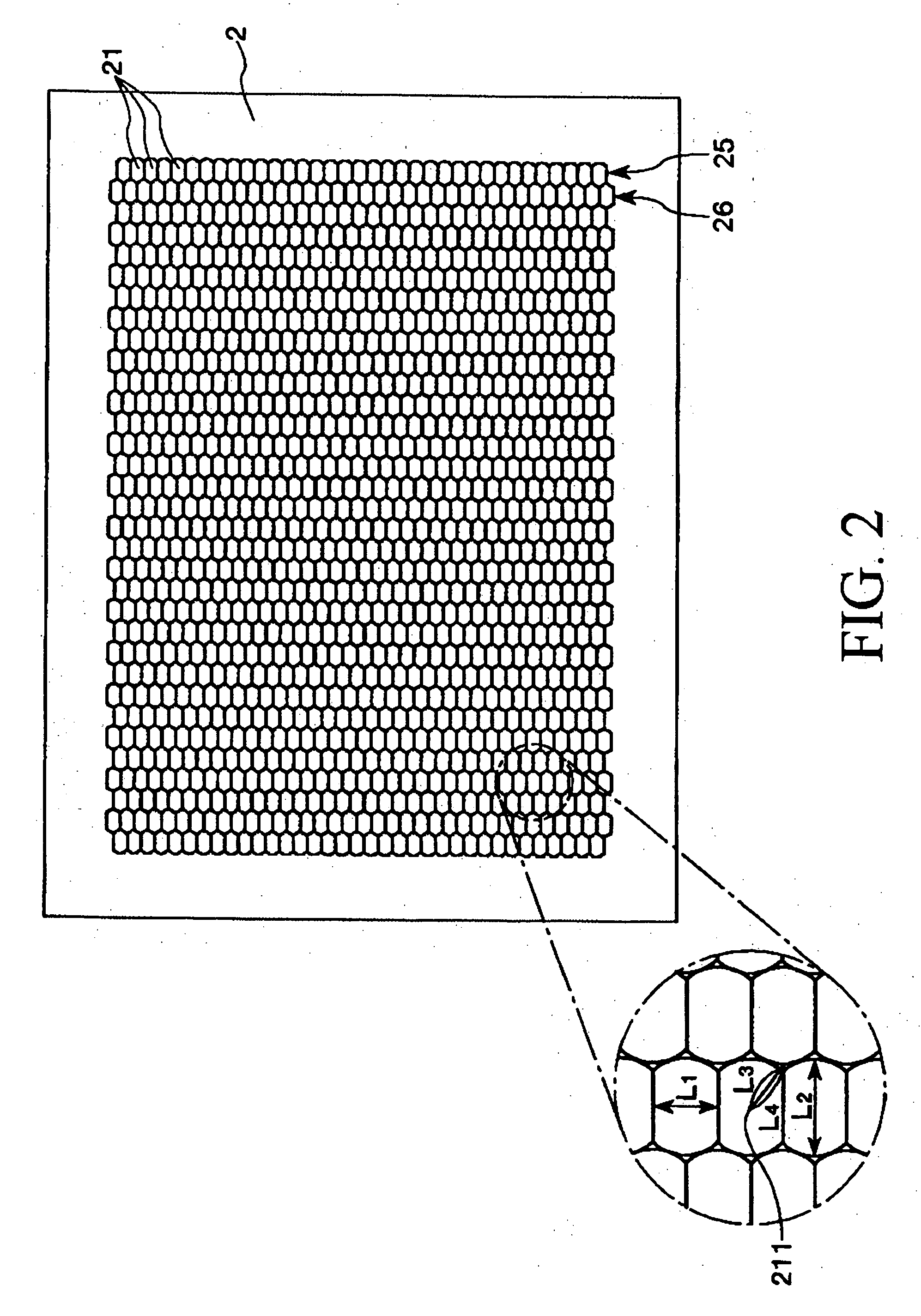Method of manufacturing a substrate with concave portions, a substrate with concave portions, a microlens substrate, a transmission screen, and a rear projection
a technology of concave portions and transmission screens, which is applied in the direction of lenses, instruments, other domestic objects, etc., can solve the problems of low light use efficiency of transmission screens provided with microlenses, interference of light passing through each of the microlenses with each other, and small vertical angle of view. , to achieve the effect of excellent angle of view characteristics
- Summary
- Abstract
- Description
- Claims
- Application Information
AI Technical Summary
Benefits of technology
Problems solved by technology
Method used
Image
Examples
example 1
[0179] A substrate with concave portions that was provided with a plurality of concave portions for forming microlenses was manufactured in the following manner.
[0180] First, a soda-lime glass substrate having a rectangle shape of 1.2 m (lateral)×0.7 m (longitudinal) and a thickness of 4.8 mm was prepared.
[0181] The soda-lime glass substrate was soaked in cleaning liquid containing 4% by weight ammonium hydrogen difluoride and 8% by weight sulfuric acid to carry out a 6 μm etching process, thereby cleaning its surface. Then, cleaning with pure water and drying with nitrogen (N2) gas (for removal of pure water) were carried out.
[0182] Next, a laminated structure of chromium / chromium oxide (that is, laminated structure in which a layer formed of chromium was laminated on the outer circumference of a layer formed of chromium oxide) was formed on one major surface of the soda-lime glass substrate by means of a spattering method. Namely, a mask and a back surface protective film each ...
example 2
[0197] The shape and / or arrangement pattern of each of the concave portions in the substrate with concave portions were changed by appropriately changing irradiation conditions for the laser beams (that is, shape of each of the initial holes to be formed), and / or a soak time into an etchant. In this way, a main substrate was manufactured in the manner similar to that in Example 1 except that the shape and / or arrangement pattern of the microlenses to be formed in the microlens substrate were changed as shown in TABLE 1. In this case, by changing the size of each of spacers at this time, the thickness of the resin layer of the main substrate (portion except for the microlenses) was set to 0.005 mm.
[0198] Then, a positive type photopolymer to which a light shielding material (carbon black) was added (PC405G: made by JSR Corporation) was supplied onto the light emission surface of the main substrate (the surface opposite to the surface on which the microlenses had been formed) by means...
examples 3 to 11
[0205] A microlens substrate and a transmission screen were manufactured in the manner similar to those in Example 1 described above except that the shape of each of the concave portions and the arrangement pattern of the concave portions of the substrate with concave portions were changed by changing any of the configuration of the mask, the conditions of the irradiation with laser beams (that is, the shape of each of the initial holes to be formed and the depth of each of the initial concave portions) and the soaking time into the etchant, whereby the shape of each of the microlenses to be formed on the microlens substrate and the arrangement pattern of the microlenses were changed as shown in TABLE 1.
PUM
 Login to View More
Login to View More Abstract
Description
Claims
Application Information
 Login to View More
Login to View More - R&D
- Intellectual Property
- Life Sciences
- Materials
- Tech Scout
- Unparalleled Data Quality
- Higher Quality Content
- 60% Fewer Hallucinations
Browse by: Latest US Patents, China's latest patents, Technical Efficacy Thesaurus, Application Domain, Technology Topic, Popular Technical Reports.
© 2025 PatSnap. All rights reserved.Legal|Privacy policy|Modern Slavery Act Transparency Statement|Sitemap|About US| Contact US: help@patsnap.com



